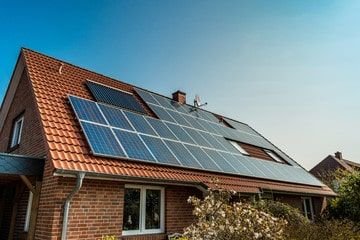Do you know the benefits of going solar? It’s not just saving money and being environmentally conscious. There are tax credits and other money-saving benefits you get.
But you must first know the cost of solar panels and other system parts.
This article discusses the average cost of solar panels for your home. The installation cost and where to try to get cheaper solar panels.
Also, we point out other solar energy systems you can get depending on what you already have and where you live. Keep reading to learn more.
Size of the System
The average cost of solar panels depends on the size of the system. Smaller solar panels, such as a single panel or a few panels, are generally much less expensive than residential or commercial ones.
A single solar panel is typically around $200-$400, and a few panels can range from $1,500 to $4,000, depending on the wattage. For residential solar systems, costs range from $11,000-$19,000 and come in a solar panel array (up to 10kW).
Generally, larger systems will cost more due to the added components. A 10 kW system could cost as low as $12,000 and as high as $20,000, whereas a 2 kW system would only cost between $5,000 and $8,000.
Commercial solar systems can cost upwards of $50,000 as they are much more powerful, ranging from 100kW to 1MW. The larger the system, the more efficient and powerful it can be, which is why some larger designs can be more expensive. It’s vital to consider the system size required for your need to assess the cost.
Manufacturer Used
The average cost of solar panels depends on the manufacturer used. High-end models can be in the range of $2.00 to $4.00 per watt for direct purchases. Lower-cost materials may be available from some manufacturers, but installation may still have a cost of $2.70 to $3.50 per watt.
For example, a solar PV system with a 5 kW installed capacity could range from around $15,000 to $20,000. Depending on the types of solar panels, the quality of the installation, and the brand of the equipment purchased. Generally speaking, reputable manufacturers tend to offer higher-quality equipment and better warranties.
Different States and Regions
The average cost of solar panels varies across states and regions. In states like Hawaii and California, electricity costs are higher and solar incentives are higher. The average price is about $4/watt for a 6 kW system.
In states like Oklahoma and Mississippi, electricity costs and incentives are low. The average price is approximately $3.00 to $3.50 per watt. The U.S. average cost of solar across all states is around $3.50 to $3.76/watt.
The most crucial factor to consider when factoring in solar panel costs is the region you are located in. The available incentives will have the most noticeable impact on overall costs.
Average Cost of Solar Panels Installation
The average cost of solar panel installations varies greatly. The cost is determined by the equipment and installation required and the location. A standard home solar setup costs between $11,214 to $14,406 before any applicable tax credits or incentives.
This cost can be broken down into equipment and labor costs. The equipment usually makes up most of the cost and can range anywhere from $6,000 to $10,000+. Labor costs are typically lower and may be between $1,000 – $3,000.
The total cost of installation should be discussed with the solar panel installer. You can find services in your local area or online, such as Blue Raven Solar or home improvement centers. When shopping for solar panels, consider the type, size, and performance of the components you need for the system.
Additionally, solar panel prices should always factor into the overall equation. Depending on the system’s size, type, and location, most solar panels purchased will last up to 25 years. This makes the cost and effort worthwhile in the long run.
Financing Options
Financing options vary but can be broken down into three categories: purchasing outright, leasing, and loan financing. Purchasing outright is the most expensive option, but it costs no monthly. Leasing and loan financing are cost-effective but require a monthly payment.
Generally, loan financing offers lower interest rates and an upfront payment. Loan financing provides an equity option, and loan terms are longer than with leasing. Businesses and homeowners should choose the best financing option for them: cash flow and long-term savings.
Financing options are available to make the transition to solar energy easier. Homeowners can use a secured loan to finance their solar installation. Utility companies are also offering loan programs, rebates, and incentives to help with the cost of solar energy.
There are unsecured solar loans available with no money down and no collateral. After installation, solar owners may be eligible for government tax incentives, ranging from federal to state and local credits.
Tax credits can reduce solar costs by up to 30%, depending on the type of system. Solar financing options allow homeowners to switch to renewable energy with manageable monthly payments.
The Complexity of the Setup
The average cost of solar panel installation can be complex. The cost of the photovoltaic (PV) hardware, wiring, charge controllers, and the necessary panels adds up. Also, many households need unique roof technology, extra roofing and labor costs, and costs for permits, inspections, and other fees.
The average price also depends on the setup size and whether the installation is done professionally or on a DIY basis. A professionally installed solar panel setup can cost around $3 per watt. This can quickly add tens of thousands of dollars for systems that power most homes.
However, with the rise of new and better technologies, the setup cost can be reduced, making solar power a viable and more affordable option for more people.
Learn How To Save With Solar Energy
The average cost of solar panels can vary greatly depending on the type and size needed for your home. Researching different styles and prices can help you find the best option. Furthermore, state incentives may be available to help you save on your installation costs.
Contact a local certified solar installer to learn how to save with solar energy.
Do you want to find more helpful info? Check out more of our guides on our blog today!






